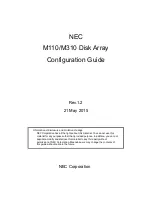
Chapter 5 Setup
5.1 Basic Setup
FUJITSU Storage ETERNUS DX60 S2 Disk storage system User’s Guide -Installation-
94
Copyright 2014 FUJITSU LIMITED
P3AM-5502-05ENZ0
2
Create RAID Group
Create or select a RAID group in which a volume is created (a group of disks configuring
RAID in the storage system device).
IMPORTANT
•
For regions other than EMEA&I, this setting is not required when
the RAID groups are set with the factory default settings. To
change the factory default settings, delete the factory settings
(LUN mappings, volumes, and RAID groups) and then create
your own RAID groups. For details on deleting factory settings,
refer to "ETERNUS Web GUI User's Guide".
•
For RAID5, RAID5+0, and RAID6, ensure that a single RAID
group is not being configured by too many disks. Doing so may
increase the time to perform data restoration from parities and
Rebuild/Copyback when a disk fails.
•
Disks with different types can be installed in a single Drive
Enclosure. However, all disks configuring a RAID group should be
of the same type. Do not include disks with a different type in a
RAID group.
•
Use disks that have the same capacity and speed to configure
RAID groups.
-
If a RAID group is configured with disks that have different
capacities, all the disks in the RAID group are recognized as
having the same capacity as the disk with the smallest
capacity in the RAID group and the rest of the capacity in the
disks that have a larger capacity cannot be used.
-
If a RAID group is configured with disks that have different
speeds, the performance of the RAID group is reduced to the
speed of the disk that has the lowest speed.
CAUTION
Do
•
Data may not be recovered if a disk fails because RAID0
configuration is not redundant. RAID1, RAID1+0, RAID5,
RAID5+0, and RAID6 are recommended as the RAID level.
















































